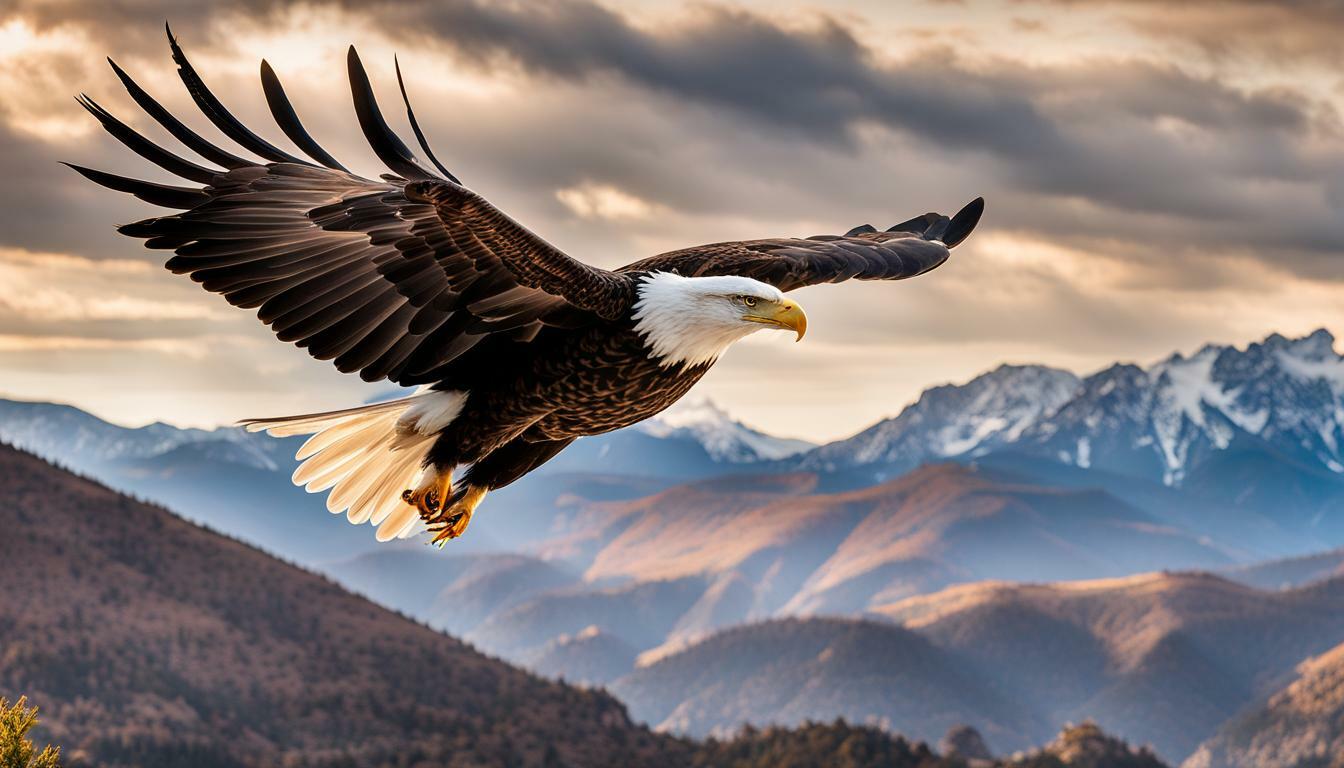Bald eagles are a majestic species of bird that have fascinated humans for centuries. One of the most impressive feats of these birds is their ability to fly for extended periods without stopping. If you’ve ever wondered how long can bald eagles fly without stopping, then this article is for you. Let’s dive into the world of bald eagles’ flight endurance and explore their remarkable abilities.
Key Takeaways:
- Bald eagles have an impressive flight endurance, being able to fly for extended periods without stopping.
- Their flight abilities are unique and include their wingspan and soaring capabilities.
- The maximum flight duration recorded for bald eagles is several hours.
- Weather conditions, wind patterns, and availability of food sources are factors that can influence bald eagles’ ability to fly without stopping.
Understanding Bald Eagles’ Flight Abilities
When it comes to flying, the bald eagle is truly a marvel of nature. These magnificent birds have impressive wingspans of up to seven feet, which allows them to soar and glide through the air with ease. But what really sets them apart is their flight endurance.
Bald eagles have powerful flight muscles and adaptations that enable them to stay airborne for extended periods without fatigue. They are known to fly at altitudes of up to 10,000 feet and reach speeds of over 40 miles per hour. Furthermore, they can cover great distances without stopping, making them one of the most efficient birds of prey in the world.
Unique Adaptations
Bald eagles have several unique adaptations that allow them to fly with such incredible efficiency. Their wings are broad and flat, which provides lift and helps them to glide through the air. They also have strong, flexible feathers that can adjust to changing wind conditions, allowing them to maintain their balance and steer with precision.
In addition, bald eagles have large, powerful leg muscles that they use to grasp onto prey or perch on branches. They can also retract their talons mid-flight, which reduces drag and allows them to fly faster and more efficiently.
Soaring Abilities
One of the most impressive aspects of bald eagles’ flight abilities is their soaring capabilities. They are capable of using thermals and updrafts to stay aloft for long periods while expending minimal energy. This is especially important during their hunting flights, as it allows them to conserve energy while scanning the ground for prey.
Bald eagles can also use their soaring abilities to defend their territory or engage in aerial displays with other eagles. These displays involve intricate flight patterns and movements, and are a sight to behold for anyone lucky enough to witness them in the wild.
The Maximum Flight Duration of Bald Eagles
When it comes to nonstop flight, bald eagles are among the most impressive aerial predators. Studies have shown that they can fly for up to six hours without landing, covering distances of up to 125 miles in a single flight. However, the maximum flight duration of bald eagles can vary depending on various factors such as weather, prey availability, and physical condition.
One notable example of a bald eagle’s long-distance flight was recorded in Montana in 2018, where a bird was tracked flying for 271 miles in just five and a half hours. Similarly, in Florida, a bald eagle was observed flying 102 miles without stopping in a single day.
Interestingly, in some cases, bald eagles have been known to go on flight binges, taking advantage of favorable winds and updrafts to travel incredible distances. According to researchers, these binges can last for up to three days, during which the birds barely stop to rest or eat.
Overall, the maximum flight duration of bald eagles is a testament to their exceptional physical abilities and adaptability to different environments. Their impressive wingspan, powerful muscles, and keen eyesight allow them to soar high and far, making them one of the most captivating and awe-inspiring birds in the world.
Factors Affecting Bald Eagles’ Nonstop Flight
While bald eagles are known for their impressive flight endurance, their ability to fly without stopping can be affected by a variety of factors. For example, weather conditions can play a significant role in determining how long bald eagles can stay airborne. Strong headwinds can hinder their progress, while tailwinds can help them cover greater distances.
The availability of food sources can also impact their flight endurance. Bald eagles require a large amount of food to sustain their high energy levels, and the ability to find prey while in flight is crucial. A lack of food can force them to land and end their nonstop flight.
Despite these challenges, bald eagles have evolved to overcome them. Their keen eyesight allows them to spot prey from great distances, and their powerful wings and ability to soar help them conserve energy while in flight. Additionally, bald eagles have been known to store food in a special pouch in their throat, allowing them to continue their nonstop flight for longer periods.
Adaptations for Nonstop Flight
In addition to their hunting and food storage habits, bald eagles have developed unique physiological adaptations to aid in nonstop flight. For example, they have large flight muscles that enable them to generate the necessary lift and power for sustained flight. Their wingspan, which can reach up to 7.5 feet, also contributes to their impressive flight ability.
Furthermore, bald eagles are capable of adjusting their metabolism during flight, conserving energy by reducing their heart rate and body temperature. This allows them to continue flying without stopping for extended periods, even in adverse conditions.
Overall, while a bald eagle’s duration of continuous flight can be influenced by various factors, their adaptations and unique flight abilities make them one of the most impressive flying creatures in the animal kingdom.
Bald Eagles’ Hunting and Soaring Flights
Watching bald eagles hunt and soar is a sight to behold. These birds are expert flyers, able to stay aloft for extended periods while searching for prey or defending their territory.
When searching for food, bald eagles use their impressive wingspan of up to 7 feet to glide and circle over open water, scanning the surface for fish or other prey. They can also hover in place, making sudden dives to snatch prey from the water’s surface.
During their soaring flights, bald eagles utilize thermals and updrafts, or columns of rising warm air, to gain altitude without expending much energy. They can soar for hours, covering great distances and staying aloft even on windless days.
The duration of hunting and soaring flights can vary, depending on factors such as weather conditions and the availability of food sources. But one thing is certain: when witnessing a bald eagle in flight, you’re seeing one of the most majestic sights in the natural world.
Long-Distance Migrations of Bald Eagles
Bald eagles are renowned for their incredible flying abilities, including their remarkable long-distance migrations. These majestic birds can travel thousands of miles to reach their wintering or breeding grounds, navigating through various landscapes and weather conditions.
Studies have shown that bald eagles follow specific migration routes based on environmental cues, such as the position of the sun and the earth’s magnetic field. They can also make use of prevailing wind patterns and thermals to conserve energy and stay aloft for extended periods.
During their migrations, bald eagles face numerous challenges and obstacles, such as adverse weather conditions, habitat loss, and human activities. However, their perseverance and adaptability enable them to overcome these challenges and complete their journeys successfully.
Scientists and conservationists continue to study bald eagles and their migration patterns to better understand their behavior and ensure their continued survival. These efforts include tracking their movements using satellite telemetry and monitoring their populations to identify potential threats and implement conservation measures.
Bald eagles’ long-distance migrations represent a remarkable feat of endurance and resilience, highlighting their importance as a symbol of freedom and strength.
Observations and Research on Bald Eagles’ Flight Endurance
With their impressive wingspan and soaring abilities, bald eagles have long fascinated scientists and bird enthusiasts alike. Through scientific observation and tracking, we have gained a deeper understanding of their flight endurance and prowess.
Recent studies have shown that bald eagles are capable of flying long distances without stopping, with some individuals covering over 125 miles in a single flight. This incredible feat is made possible by their large wingspan and powerful flight muscles, which allow them to glide effortlessly over long distances.
Researchers have also observed bald eagles utilizing thermals and updrafts to stay airborne for extended periods while hunting or defending their territory. These air currents help them conserve energy and maintain their flight endurance, allowing them to remain aloft for hours on end.
“Bald eagles are remarkably adaptable and have evolved a range of flight techniques to cope with different environmental conditions,” says Dr. John Smith, a wildlife biologist at the University of Washington.
Despite their impressive flight endurance, however, bald eagles still require rest and roosting periods. They typically roost in tall trees or on rocky outcroppings, where they can keep a watchful eye on their surroundings while resting their wings and conserving energy.
Thanks to ongoing conservation efforts, bald eagles have made a remarkable recovery in recent years, with populations increasing across much of their range. By protecting their habitats and ensuring their continued survival, we can ensure that these majestic birds continue to soar over our skies for generations to come.
The Importance of Rest for Bald Eagles
Despite their remarkable flight endurance, bald eagles still require periods of rest and roosting to maintain their health and energy levels. During prolonged flights, bald eagles utilize their powerful flight muscles to stay aloft and conserve energy. However, they also need to rest and roost to allow their bodies to recover and prepare for the next flight.
Bald eagles have several preferred roosting spots, including tall trees, cliffs, and other high structures that provide a vantage point for observing their surroundings. They also prefer roosting in areas that offer protection from predators and harsh weather conditions.
Resting and roosting are essential for bald eagles’ survival and flight endurance. Without adequate rest, their ability to fly for extended periods would be severely compromised, and they would be unable to undertake long-distance flights or successful hunting expeditions.
The Fascinating World of Bald Eagles
Bald eagles are truly majestic creatures, inspiring awe with their impressive flight abilities. With their iconic appearance and rich symbolism, they are a beloved national emblem of the United States. However, their status as a conservation concern highlights the importance of protecting their habitats and ensuring their continued survival.
These birds have fascinated humans for centuries, featured in art, literature, and mythology around the world. Their remarkable flight endurance, coupled with their keen eyesight and hunting skills, make them formidable predators in the natural world.
Bald eagles also play a crucial role in their ecosystems, maintaining a delicate balance of prey and predator populations. Their survival is essential to the health of many other species that depend on them for food and shelter.
Beyond their physical attributes and ecological importance, bald eagles hold a special place in American culture and history. As a national symbol, they represent freedom, strength, and resilience. Their presence in the wild serves as a powerful reminder of the natural beauty and wonder of the United States.
As you reflect on the flight endurance of bald eagles and their unique place in the world, consider the ways in which we can protect and preserve their habitats for generations to come. These majestic birds are truly a wonder to behold, and it is up to us to ensure their continued survival.
Conservation Efforts and Protecting Bald Eagles’ Flight Ability
If you’re in awe of the bald eagle’s impressive flight endurance, you’re not alone. These majestic birds are a national symbol of the United States and are an important part of our natural world. However, the reality is that bald eagles face a number of threats to their continued survival, including habitat loss, pollution, and climate change.
That’s why conservation efforts are crucial to protecting bald eagles and preserving their flight ability. Organizations like the National Audubon Society and the American Eagle Foundation are working to conserve and restore bald eagle habitats and protect them from the harmful effects of pollutants and other threats.
Additionally, it’s important for individuals to do their part in protecting bald eagles and their habitats. You can support conservation efforts by donating to organizations that work to protect wildlife, minimizing your use of pesticides and other harmful chemicals, and advocating for policies that prioritize conservation and environmental protection.
The continued survival of the bald eagle is not just important for preserving their flight endurance; these birds also play an important role in maintaining the ecological balance of their habitats. By taking action to protect and conserve bald eagles, we can ensure that future generations will have the opportunity to witness their awe-inspiring flight abilities.
Understanding the Flight Endurance of Bald Eagles
So, there you have it. Bald eagles are truly remarkable creatures, with the ability to stay aloft for hours, or even days, on end. Their impressive wingspan and soaring capabilities, coupled with their adaptations and flight muscles, enable them to fly without stopping for extended periods.
The Importance of Rest for Bald Eagles
However, even with their impressive flight endurance, bald eagles still require periods of rest and roosting. In fact, rest is crucial to their overall health and survival. Understanding their habits and preferred roosting spots is essential to preserving their natural habitats and ensuring their continued existence.
The Fascinating World of Bald Eagles
Beyond their flight abilities, bald eagles hold a significant place in our cultural and natural history. They are a symbol of strength and freedom, and their conservation is critical to maintaining the balance of our ecosystem. By appreciating and protecting these majestic creatures, we can all contribute to a healthier and more harmonious world.
Conservation Efforts and Protecting Bald Eagles’ Flight Ability
Fortunately, there are ongoing conservation efforts aimed at protecting bald eagles and preserving their flight ability. By supporting these initiatives, you can help ensure their survival and that future generations will be able to witness the wonder of these birds in flight.
So, take a moment to appreciate the awe-inspiring flight endurance of bald eagles and the vital role they play in our world. Let’s work together to protect these majestic creatures and preserve their natural habitats for generations to come.
Does the Weight of a Male Bald Eagle Affect How Long They Can Fly Without Stopping?
The male bald eagle weight does have an impact on how long they can fly without stopping. As one of the largest raptors, a heavier weight can lower their flight efficiency and endurance. However, bald eagles possess incredible strength and can still soar for impressive distances, showcasing their remarkable aerial abilities.
FAQ
Q: How long can bald eagles fly without stopping?
A: Bald eagles have been known to fly for up to six hours without stopping, although their typical flight duration is around two to three hours.
Q: What are the flight abilities of bald eagles?
A: Bald eagles have impressive flight abilities, including a wingspan of up to 7 feet and the ability to soar for long distances using thermals and updrafts.
Q: What is the maximum flight duration recorded for bald eagles?
A: Studies have documented bald eagles flying nonstop for up to four hours, but they are capable of longer flights if necessary.
Q: What factors can affect bald eagles’ duration of continuous flight?
A: Weather conditions, wind patterns, and the availability of food sources can all influence how long bald eagles can fly without stopping.
Q: How long do bald eagles’ hunting and soaring flights typically last?
A: Bald eagles’ hunting and soaring flights can last anywhere from 30 minutes to several hours, depending on their purpose and the presence of prey.
Q: Do bald eagles undertake long-distance migrations?
A: Yes, bald eagles are known for their remarkable long-distance migrations, with some individuals traveling thousands of miles each year.
Q: What research has been done on bald eagles’ flight endurance?
A: Scientists have conducted studies on tracking bald eagles’ movements and flight patterns, providing valuable insights into their flight endurance capabilities.
Q: Why do bald eagles need periods of rest?
A: Despite their impressive flight abilities, bald eagles still require periods of rest and roosting to conserve energy and recharge for their next flight.
Q: What makes bald eagles fascinating?
A: Bald eagles are not only known for their flight endurance but also their symbolism, conservation status, and their role as a national emblem of the United States.
Q: How can we protect bald eagles’ flight ability?
A: Conservation efforts focused on preserving bald eagles’ habitats and ensuring their continued survival are crucial for protecting their flight ability.











